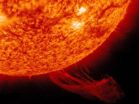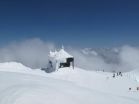(Press-News.org) Imagine riding in an airplane as the plane is jolted back and forth by gusts of wind that you can't prove exist but are there nonetheless.
Similar turbulence exists in space, and a research team led by the University of Iowa reports to have directly measured it for the first time in the laboratory.
"Turbulence is not restricted to environments here on Earth, but also arises pervasively throughout the solar system and beyond, driving chaotic motions in the ionized gas, or plasma, that fills the universe," says Gregory Howes, assistant professor of physics and astronomy at the UI and lead author of the paper to be published Dec. 17 in the online edition of Physical Review Letters, the journal of the American Physical Society. "It is thought to play a key role in heating the atmosphere of the sun, the solar corona, to temperatures of a million degrees Celsius, nearly a thousand times hotter than the surface of the sun."
He adds: "Turbulence also regulates the formation of the stars throughout the galaxy, determines the radiation emitted from the super massive black hole at the center of our galaxy and mediates the effects that space weather has on the Earth."
One well-known source of gusty space winds are the violent emissions of charged particles from the sun, known as coronal mass ejections. These solar-powered winds can adversely affect satellite communications, air travel and the electric power grid. On the positive side, solar storms also can also lead to mesmerizing auroras at the north and south poles on Earth.
Howes notes that unlike gusts of wind on the surface of the Earth, turbulent motions in space and astrophysical systems are governed by Alfven waves, which are traveling disturbances of the plasma and magnetic field. Nonlinear interactions between Alfven waves traveling up and down the magnetic field—such as two magnetic waves colliding to create a third wave—are a fundamental building block of plasma turbulence, and modern theories of astrophysical turbulence are based on this underlying concept, he says.
"We have presented the first experimental measurement in a laboratory plasma of the nonlinear interaction between counter-propagating Alfven waves, the fundamental building block of astrophysical turbulence," Howes says.
INFORMATION:
Contributing authors on the paper are D.J. Drake, K.D. Nielson, Craig Kletzing, and Fred Skiff, all of the University of Iowa, and T.A. Carter of the University of California, Los Angeles. The research, conducted at the Large Plasma Device at UCLA, was funded by a grant from the NSF/DOE Partnership in Basic Plasma Science and Engineering.
Preprints of the abstract and paper, "Toward Astrophysical Turbulence in the Laboratory," (PDF download) are available at: http://lanl.arxiv.org/abs/1210.4568
Howes is a 2010 Presidential Early Career Awards for Scientists and Engineers recipient. In 2011, he won a five-year Faculty Early Career Development Award from the NSF to study the near-Earth solar wind.
UI-led team confirms 'gusty winds' in space turbulence
Study is first direct measurement of its kind in the lab
2012-12-18
ELSE PRESS RELEASES FROM THIS DATE:
Berkeley Lab scientists developing quick way to id people exposed to ionizing radiation
2012-12-18
There's a reason emergency personnel train for the aftermath of a dirty bomb or an explosion at a nuclear power plant. They'll be faced with a deluge of urgent tasks, such as identifying who's been irradiated, who has an injury-induced infection, and who's suffering from both.
Unfortunately, there isn't a quick way to screen for people exposed to dangerous levels of radiation. There also isn't a quick way to distinguish between people suffering from radiation exposure versus an infection due to an injury or chemical exposure.
The most common way to measure exposure ...
Chances seen rising for chikungunya outbreaks in NYC, Atlanta, Miami
2012-12-18
ITHACA, N.Y. – Global travel and climate warming could be creating the right conditions for outbreaks of a new virus in this country, according to a new Cornell University computer model.
The model predicts that outbreaks of chikungunya, a painful virus transported by travelers and spread by the invasive Asian tiger mosquito, could occur in 2013 in New York City during August and September, in Atlanta from June through September, and year-round in Miami. The probability of a disease outbreak is correlated with temperature, as warmer weather allows the Asian tiger mosquito ...
Plumes across the Pacific deliver thousands of microbial species to West Coast
2012-12-18
A surprising number of microorganisms – 99 percent more kinds than had been reported in findings published just four months ago – are leaping the biggest gap on the planet. Hitching rides in the upper troposphere, they're making their way from Asia across the Pacific Ocean and landing in North America.
For the first time researchers have been able to gather enough biomass in the form of DNA to apply molecular methods to samples from two large dust plumes originating in Asia in the spring of 2011. The scientists detected more than 2,100 unique species compared to only ...
2 cups of milk a day ideal for children's health, new research shows
2012-12-18
TORONTO, Dec. 17, 2012—New research has answered one of the most common questions parents ask their doctors: How much milk should I be giving my children? The answer is two cups per day.
"We started to research the question because professional recommendations around milk intake were unclear and doctors and parents were seeking answers," said Dr. Jonathon Maguire, a paediatrician at St. Michael's Hospital and the lead author of the study.
Dr. Maguire and his team looked at how cow's milk affected body stores of iron and vitamin D – two of the most important nutrients ...
Dust-plumes power intercontinental microbial migrations
2012-12-18
Along with pollutants from Asia, transpacific dust plumes deliver vast quantities of microbes to North America, according to a manuscript published online ahead of print in the journal Applied and Environmental Microbiology.
"We detected thousands of unique microbial species, many of which seem particularly well-suited for atmospheric transport," says first author David J. Smith, a graduate student at the University of Washington, Seattle. "We also detected archaea, a domain of life that has never before been sampled at high altitude. We are just starting to understand ...
RIT scientists decode 3 bacterial strains common to grapevines and sugarcane
2012-12-18
Scientists at Rochester Institute of Technology have published the whole genome sequence of bacteria associated with Jamaican sugarcane and Riesling grapevines in the September and November issues of the Journal of Bacteriology, a publication of the American Society for Microbiology.
André Hudson and Michael Savka, professors in RIT's Thomas H. Gosnell School of Life Sciences within the College of Science, isolated and identified three bacteria belonging to the genus Enterobacter from Jamaican sugarcane stalk tissue and Methylobacterium and Novosphingobium from grapevines.
These ...
Notre Dame's Reilly Center highlights emerging ethical dilemmas in science and technology
2012-12-18
As a new year approaches, the University of Notre Dame's John J. Reilly Center for Science, Technology and Values has announced its first annual list of emerging ethical dilemmas and policy issues in Science and Technology for 2013.
The Reilly Center explores conceptual, ethical and policy issues where science and technology intersect with society from different disciplinary perspectives. Its goal is to promote the advancement of science and technology for the common good.
The center generated its first annual list of emerging ethical dilemmas and policy issues in science ...
People with HIV hospitalized less often since combination antiretroviral drug therapy introduced
2012-12-18
TORONTO, Dec. 17, 2012—People with HIV are being hospitalized in Ontario significantly less often than they were 15 years ago when combination antiretroviral drug therapy (cART) was introduced, new research has found.
However, women with HIV are still hospitalized more than men with HIV as are low-income people with HIV compared with high-income people with HIV, according to a study by Tony Antoniou, a pharmacist and researcher in the Department of Family Medicine at St. Michael's Hospital.
Immigrants with HIV who had been in Ontario three years or less had lower rates ...
Following Phragmites home
2012-12-18
Phragmites australis, an invasive species of plant called common reed, grows rapidly into dense stands of tall plants that pose an extreme threat to Great Lakes coastal wetlands. Early treatment is the key to controlling Phragmites.
But how can these invasive reeds be eradicated before they take over their environment if we don't know where they are?
Now we do know, thanks to scientists from Michigan Technological University's Michigan Tech Research Institute (MTRI), the US Geological Survey (USGS), Boston College and the US Fish and Wildlife Service (USFWS). They mapped ...
NASA sees dangerous category 4 Cyclone Evan lashing Fiji
2012-12-18
Cyclone Evan is one of the strongest cyclones to affect Fiji in almost two decades, and NASA satellites are analyzing the storm and providing data on rainfall, cloud height, temperature data and more to forecasters.
According to NBC News, over 3,500 people in Fiji went to emergency shelters. Today, Dec. 17, Evan is lashing Fiji, just days after battering Samoa where it killed at least three people and left thousands homeless.
On Monday, Dec. 17 many warnings and watches were in effect. A tropical cyclone warning is in effect for Fiji. A Hurricane warning is in effect ...
LAST 30 PRESS RELEASES:
Jeonbuk National University study shows positive parenting can protect adolescents against self-harm
Surface-engineered ZnO nanocrystals to tackle perfluoroalkyl substance contamination
This new understanding of T cell receptors may improve cancer immunotherapies
A new fossil face sheds light on early migrations of ancient human ancestor
A new immunotherapy approach could work for many types of cancer
A new way to diagnose deadly lung infections and save lives
40 percent of MRI signals do not correspond to actual brain activity
How brain-inspired algorithms could drive down AI energy costs
Gum disease may be linked to plaque buildup in arteries, higher risk of major CVD events
Contrails are a major driver of aviation’s climate impact
Structure of dopamine-releasing neurons relates to the type of circuits they form for smell-processing
Reducing social isolation protects the brain in later life
Keeping the heart healthy increases longevity even after cancer
Young adults commonly mix cannabis with nicotine and tobacco
Comprehensive review illuminates tau protein's dual nature in brain health, disease, and emerging psychiatric connections
Book prepares K-12 leaders for the next public health crisis
Storms in the Southern Ocean mitigates global warming
Seals on the move: Research reveals key data for offshore development and international ecology
Sports injuries sustained during your period might be more severe
World's first successful 2 Tbit/s free-space optical communication using small optical terminals mountable on satellites and HAPS
Can intimate relationships affect your heart? New study says ‘yes’
Scalable and healable gradient textiles for multi‑scenario radiative cooling via bicomponent blow spinning
Research shows informed traders never let a good climate crisis go to waste
Intelligent XGBoost framework enhances asphalt pavement skid resistance assessment
Dual-function biomaterials for postoperative osteosarcoma: Tumor suppression and bone regeneration
New framework reveals where transport emissions concentrate in Singapore
NTP-enhanced lattice oxygen activation in Ce-Co catalysts for low-temperature soot combustion
Synergistic interface engineering in Cu-Zn-Ce catalysts for efficient CO2 hydrogenation to methanol
COVID-19 leaves a lasting mark on the human brain
Scientists use ultrasound to soften and treat cancer tumors without damaging healthy tissue
[Press-News.org] UI-led team confirms 'gusty winds' in space turbulenceStudy is first direct measurement of its kind in the lab



